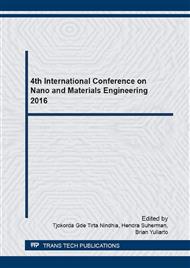[1]
H. Zhou, C. -J. Hsu, W. -C. Hsu, H. -S. Duan, C. -H. Chung, W. Yang, et al., Non-Hydrazine Solutions in Processing CuIn(S, Se)2 Photovoltaic Devices from Hydrazinium Precursors, Advanced Energy Materials, vol. 3, pp.328-336, (2013).
DOI: 10.1002/aenm.201200691
Google Scholar
[2]
B. Bob, B. Lei, C. -H. Chung, W. Yang, W. -C. Hsu, H. -S. Duan, et al., The Development of Hydrazine-Processed Cu(In, Ga)(Se, S)2 Solar Cells, Advanced Energy Materials, vol. 2, pp.504-522, (2012).
DOI: 10.1002/aenm.201100578
Google Scholar
[3]
N. G. Dhere, Toward GW/year of CIGS production within the next decade, Solar Energy Materials and Solar Cells, vol. 91, pp.1376-1382, 9/22/ (2007).
DOI: 10.1016/j.solmat.2007.04.003
Google Scholar
[4]
X. -J. Wu, X. Huang, X. Qi, H. Li, B. Li, and H. Zhang, Copper-Based Ternary and Quaternary Semiconductor Nanoplates: Templated Synthesis, Characterization, and Photoelectrochemical Properties, Angewandte Chemie International Edition, vol. 53, pp.8929-8933, (2014).
DOI: 10.1002/anie.201403655
Google Scholar
[5]
Q. Guo, S. J. Kim, M. Kar, W. N. Shafarman, R. W. Birkmire, E. A. Stach, et al., Development of CuInSe2 Nanocrystal and Nanoring Inks for Low-Cost Solar Cells, Nano Letters, vol. 8, pp.2982-2987, 2008/09/10 (2008).
DOI: 10.1021/nl802042g
Google Scholar
[6]
Q. Guo, G. M. Ford, H. W. Hillhouse, and R. Agrawal, Sulfide Nanocrystal Inks for Dense Cu(In1−xGax)(S1−ySey)2 Absorber Films and Their Photovoltaic Performance, Nano Letters, vol. 9, pp.3060-3065, 2009/08/12 (2009).
DOI: 10.1021/nl901538w
Google Scholar
[7]
P. Jackson, D. Hariskos, R. Wuerz, O. Kiowski, A. Bauer, T. M. Friedlmeier, et al., Properties of Cu(In, Ga)Se2 solar cells with new record efficiencies up to 21. 7%, physica status solidi (RRL) – Rapid Research Letters, vol. 9, pp.28-31, (2015).
DOI: 10.1002/pssr.201409520
Google Scholar
[8]
M. A. Green, K. Emery, Y. Hishikawa, W. Warta, and E. D. Dunlop, Solar cell efficiency tables (version 46), Progress in Photovoltaics: Research and Applications, vol. 23, pp.805-812, (2015).
DOI: 10.1002/pip.2637
Google Scholar
[9]
A. Chirilă, P. Reinhard, F. Pianezzi, P. Bloesch, A. R. Uhl, C. Fella, et al., Potassium-induced surface modification of Cu(In, Ga)Se2 thin films for high-efficiency solar cells, Nat Mater, vol. 12, pp.1107-1111, 12/print (2013).
DOI: 10.1038/nmat3789
Google Scholar
[10]
I. Repins, M. A. Contreras, B. Egaas, C. DeHart, J. Scharf, C. L. Perkins, et al., 19·9%-efficient ZnO/CdS/CuInGaSe2 solar cell with 81·2% fill factor, Progress in Photovoltaics: Research and Applications, vol. 16, pp.235-239, (2008).
DOI: 10.1002/pip.822
Google Scholar
[11]
M. A. Hossain, Z. Tianliang, L. K. Keat, L. Xianglin, R. R. Prabhakar, S. K. Batabyal, et al., Synthesis of Cu(In, Ga)(S, Se)2 thin films using an aqueous spray-pyrolysis approach, and their solar cell efficiency of 10. 5%, Journal of Materials Chemistry A, vol. 3, pp.4147-4154, (2015).
DOI: 10.1039/c4ta05783j
Google Scholar
[12]
Y. Cai, J. C. W. Ho, S. K. Batabyal, W. Liu, Y. Sun, S. G. Mhaisalkar, et al., Nanoparticle-Induced Grain Growth of Carbon-Free Solution-Processed CuIn(S, Se)2 Solar Cell with 6% Efficiency, ACS Applied Materials & Interfaces, vol. 5, pp.1533-1537, 2013/03/13 (2013).
DOI: 10.1021/am303057z
Google Scholar
[13]
W. Wang, S. -Y. Han, S. -J. Sung, D. -H. Kim, and C. -H. Chang, 8. 01% CuInGaSe2 solar cells fabricated by air-stable low-cost inks, Physical Chemistry Chemical Physics, vol. 14, pp.11154-11159, (2012).
DOI: 10.1039/c2cp41969f
Google Scholar
[14]
W. Liu, D. B. Mitzi, M. Yuan, A. J. Kellock, S. J. Chey, and O. Gunawan, 12% Efficiency CuIn(Se, S)2 Photovoltaic Device Prepared Using a Hydrazine Solution Process, Chemistry of Materials, vol. 22, pp.1010-1014, 2010/02/09 (2010).
DOI: 10.1021/cm901950q
Google Scholar
[15]
V. A. Akhavan, T. B. Harvey, C. J. Stolle, D. P. Ostrowski, M. S. Glaz, B. W. Goodfellow, et al., Influence of Composition on the Performance of Sintered Cu(In, Ga)Se2 Nanocrystal Thin-Film Photovoltaic Devices, ChemSusChem, vol. 6, pp.481-486, (2013).
DOI: 10.1002/cssc.201200677
Google Scholar
[16]
S. Ahn, K. Kim, A. Cho, J. Gwak, J. H. Yun, K. Shin, et al., CuInSe2 (CIS) Thin Films Prepared from Amorphous Cu–In–Se Nanoparticle Precursors for Solar Cell Application, ACS Applied Materials & Interfaces, vol. 4, pp.1530-1536, 2012/03/28 (2012).
DOI: 10.1021/am201755q
Google Scholar
[17]
J. C. W. Ho, T. Zhang, K. K. Lee, S. K. Batabyal, A. I. Y. Tok, and L. H. Wong, Spray Pyrolysis of CuIn(S, Se)2 Solar Cells with 5. 9% Efficiency: A Method to Prevent Mo Oxidation in Ambient Atmosphere, ACS Applied Materials & Interfaces, vol. 6, pp.6638-6643, 2014/05/14 (2014).
DOI: 10.1021/am500317m
Google Scholar
[18]
S. J. Park, J. W. Cho, J. K. Lee, K. Shin, J. -H. Kim, and B. K. Min, Solution processed high band-gap CuInGaS2 thin film for solar cell applications, Progress in Photovoltaics: Research and Applications, vol. 22, pp.122-128, (2014).
DOI: 10.1002/pip.2354
Google Scholar
[19]
T. K. Todorov, O. Gunawan, T. Gokmen, and D. B. Mitzi, Solution-processed Cu(In, Ga)(S, Se)2 absorber yielding a 15. 2% efficient solar cell, Progress in Photovoltaics: Research and Applications, vol. 21, pp.82-87, (2013).
DOI: 10.1002/pip.1253
Google Scholar
[20]
I. M. Dharmadasa, J. S. Roberts, and G. Hill, Third generation multi-layer graded band gap solar cells for achieving high conversion efficiencies—II: Experimental results, Solar Energy Materials and Solar Cells, vol. 88, pp.413-422, 9/15/ (2005).
DOI: 10.1016/j.solmat.2005.05.008
Google Scholar
[21]
S. H. Wei and A. Zunger, Band offsets and optical bowings of chalcopyrites and Zn‐based II‐VI alloys, Journal of Applied Physics, vol. 78, pp.3846-3856, (1995).
DOI: 10.1063/1.359901
Google Scholar
[22]
K. Zhang, C. -l. Yang, L. Yin, Z. Liu, Q. -m. Song, H. -l. Luo, et al., Fabricating highly efficient Cu(In, Ga)Se2 solar cells at low glass-substrate temperature by active gallium grading control, Solar Energy Materials and Solar Cells, vol. 120, Part A, pp.253-258, 1/ (2014).
DOI: 10.1016/j.solmat.2013.09.012
Google Scholar
[23]
A. Han, Y. Sun, Y. Zhang, X. Liu, F. Meng, and Z. Liu, Comparative study of the role of Ga in CIGS solar cells with different thickness, Thin Solid Films, vol. 598, pp.189-194, 1/1/ (2016).
DOI: 10.1016/j.tsf.2015.12.020
Google Scholar


